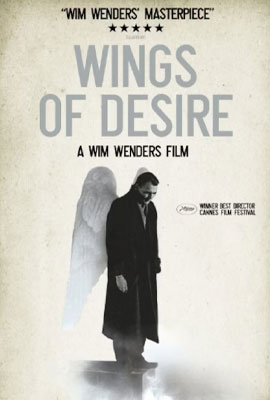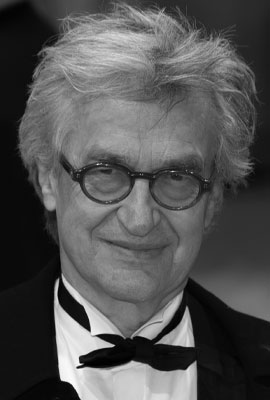
(1987)
directed by Wim Wenders
“Wings of Desire” began as a movie about the divided city of Berlin. The film’s original title was “The Sky or Heavens Over Berlin.” “Wings of Desire” is a historic record of Berlin just before the wall fell. The aerial camera work captures the city’s desolate, wintry spaces.
“Wings of Desire” is a breathtaking examination of the condition of loneliness. Often, the angels stand on high places, the shoulder of a statue, the tops of buildings. Sometimes they descend to comfort an accident victim or a person contemplating suicide. They are unseen by humans except occasionally by children and by the childlike Peter Falk who plays himself as an actor visiting Berlin. We follow two angels, Damiel (Bruno Ganz) and Cassiel (Otto Sander). They listen to the thoughts of an elderly Holocaust survivor and to the thoughts of a circus trapeze artist who fears that she will fall because it is the night of the full moon.
The trapeze artist (Solveig Dommartin) is the central figure in “Wings of Desire.” She reminds me of the trapeze artist in Fellini’s film “La Strada.” In Fellini’s film, the simple minded Gelsomina is awestruck by the performance of the Fool, a trapeze artist who works high above the city street. Fellini turns again and again to certain images. One image that appears in many of Fellini’s films is of a figure suspended between earth and sky. In “La Strada,” the Fool is that figure. Fellini would rework this image until the end of his life.
The trapeze artist in “Wings of Desire” occupies a space between the angels and earthly mortals. The scene in which she slowly spins while suspended from a rope is sublimely beautiful. Her grace, beauty, and courage are entrancing and set her apart from ordinary mortals. The image of a figure suspended between earth and sky is central to both “La Strada” and “Wings of Desire.” The image of the trapeze artist in these films is an archetype for all that is beautiful and inspiring in life. The breathtaking images of the trapeze artist in “Wings of Desire” expand our understanding of what is possible in this world.
The title of the film tells us that desire is the driving force in the film. The angel Damiel falls in love with the trapeze artist. Night after night Damiel goes to the circus where she performs. He is touched by her vulnerability. Damiel longs to leave immortality behind and decides that he must become human. He talks to Cassiel about what it would be like to taste coffee, feel the cold, or feed a cat. For Wenders and his characters, the realm of the senses is what makes life worthwhile. Damiel is willing to descend into time, pain, and eventual death because he will be able to feel, touch, and love.
“Wings of Desire” is a visual poem which reveals truths about the human condition. This extraordinary film parallels the movie-going experience because, like the angels, we are spectators unable to affect what we see on the screen. The film was shot by the cinematographer Henri Alekan, who also shot Jean Cocteau’s classic “Beauty and the Beast.” When he shows the point of view of the angels, he shoots in black and white. When he sees through human eyes, he shoots in color. The first time we see color is when the trapeze artist reveals her innermost feelings in Damiel’s presence. “Wings of Desire” won the best director prize at Cannes.
Wim Wenders

Wim Wenders, the director of “Wings of Desire,” has a special connection to America because of his early masterpiece, “Paris, Texas,” which won the Golden Palm at Cannes. “Paris, Texas” tells a story which is similar to John Ford’s “The Searchers.” Harry Dean Stanton plays a loner who tries to track down a lost girl in a desolate American landscape. The script for “Paris, Texas” was written by the American playwright Sam Shepard. The film score for “Paris, Texas” was written by Ry Cooder for the slide guitar, a uniquely American instrument. The music in the film has an open, mournful quality that captures the feel of the American West.
Wim Wenders, like Agnes Varda, approached film making from the perspective of a photographer. Wenders pursued his long-running artistic project, “Pictures from the Surface of the Earth,” alongside his filmmaking career. Wenders started work on “Pictures from the Surface of the Earth” by traveling across the American West while preparing to film “Paris, Texas.” His photographs of desolate landscapes address themes of time, memory, and loss, themes which are also addressed in his films.